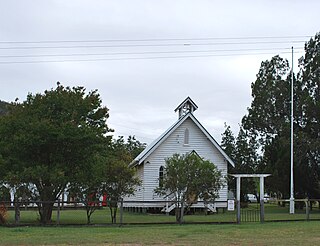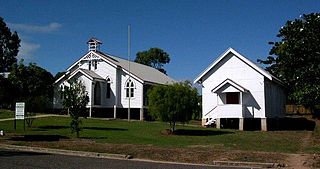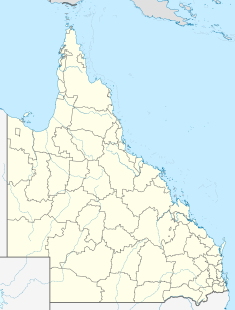
The Brisbane Showgrounds is a multi-purpose venue located in Bowen Hills, Brisbane. Established in 1875, it hosts more than 250 events each year, the largest being the Royal Queensland Show (Ekka).

Wonglepong is a rural locality in the Scenic Rim Region, Queensland, Australia. In the 2021 census, Wonglepong had a population of 364 people.

St Agnes Anglican Church is a heritage-listed churchyard at Ipswich Street, Esk, Somerset Region, Queensland, Australia. It was designed by John Hingeston Buckeridge and built in 1889 by Lars Andersen. It is also known as St Agnes Rectory and Church Hall. It was added to the Queensland Heritage Register on 21 October 1992.

University of Queensland Gatton Campus is a heritage-listed university campus of the University of Queensland at Warrego Highway, Lawes, Lockyer Valley Region, Queensland, Australia. It was built from 1897 to 1960s. It is also known as the Queensland Agricultural College, the Foundation Precinct Gatton College and Lawes Campus. It was added to the Queensland Heritage Register on 6 January 2004.

All Saints Memorial Church is a heritage-listed Anglican church at Tamrookum Church Road, Tamrookum, Scenic Rim Region, Queensland, Australia. It was designed by Robin Dods and built in 1915. It was added to the Queensland Heritage Register on 21 October 1992.

St Patrick's Church is a heritage-listed Roman Catholic church at Rosewood - Aratula Road, Rosevale, Scenic Rim Region, Queensland, Australia. It was designed by Father Andrew Horan and built from 1888 to 1889. It was added to the Queensland Heritage Register on 11 December 2009.

Schmidt Farmhouse & Outbuildings is a heritage-listed homestead at 3 Worongary Road, Worongary, City of Gold Coast, Queensland, Australia. It was built from 1880s to c. 1910. It was added to the Queensland Heritage Register on 8 April 1997.

Numinbah Valley School of Arts is a heritage-listed school of arts at Nerang–Murwillumbah Road, Numinbah Valley, City of Gold Coast, Queensland, Australia. It was added to the Queensland Heritage Register on 7 December 2007.

St John's Church is a heritage-listed Anglican church at Mundoolun Road, Mundoolun, City of Logan, Queensland, Australia. It was designed by John Hingeston Buckeridge and built from 1901 to 1915. It is also known as Memorial Church of St John the Evangelist. It was added to the Queensland Heritage Register on 26 November 1999.

Purga United Church is a heritage-listed union church at Boonah Road, Purga, City of Ipswich, Queensland, Australia. It was built in 1922. It was added to the Queensland Heritage Register on 6 September 2005.

St Brigids Catholic Church is a heritage-listed Roman Catholic church at 11 Railway Street, Rosewood, City of Ipswich, Queensland, Australia. It was designed by Reverend Andrew Horan and built in 1909 by RJ Murphy with alterations in 1935. It was added to the Queensland Heritage Register on 21 October 1992.

St Andrew's Presbyterian Church is a heritage-listed former Presbyterian church at Ipswich Street, Esk, Somerset Region, Queensland, Australia. The former church was built from 1876 to 1929, and it was added to the Queensland Heritage Register on 11 June 2003.

North Pine Presbyterian Church is a heritage-listed former Presbyterian and now Lutheran church at Dayboro Road, Whiteside, City of Moreton Bay, Queensland, Australia. The church was built from 1883 to 1884 and was added to the Queensland Heritage Register on 21 October 1992.

Langmorn Homestead is a heritage-listed homestead at Langmorn Road, Raglan, Gladstone Region, Queensland, Australia. It was built from 1873 to 1926. It was added to the Queensland Heritage Register on 21 October 1992.

Christ Church Anglican Church is a heritage-listed church at Cannon Street, St Lawrence, Isaac Region, Queensland, Australia. It was designed by Alfred Mowbray Hutton and built in 1898 by Newman Brothers. It was added to the Queensland Heritage Register on 27 October 2000.

Townsville Baptist Church is a former heritage-listed church building at 513 Sturt Street, Townsville CBD, City of Townsville, Queensland, Australia. It was built in 1922. Since 1985, it has been occupied by the Potter's House Christian Fellowship. It was added to the Queensland Heritage Register on 27 February 2004.

St John's Anglican Church Precinct is a heritage-listed churchyard at 30–34 Macrossan Street, South Townsville, City of Townsville, Queensland, Australia. It was built from c. 1907 to c. 1911. It was added to the Queensland Heritage Register on 21 October 1992.

Murgon Civic Centre is a heritage-listed town hall at 62–70 Lamb Street, Murgon, South Burnett Region, Queensland, Australia. It is also known as Murgon Public Hall. It was designed by Clifford Ernest Plant and built in 1938 by HG Neilsen. It was added to the Queensland Heritage Register on 9 November 2012.

Cactoblastis Memorial Hall is a heritage-listed memorial at Warrego Highway, Boonarga, Western Downs Region, Queensland, Australia. It was built in 1936 by Jack Schloss. It was added to the Queensland Heritage Register on 21 September 1993.

Ingham Post Office is a heritage-listed post office at 15 Lannercost Street, Ingham, Shire of Hinchinbrook, Queensland, Australia. It was built in 1935. It was added to the Australian Commonwealth Heritage List on 22 August 2012.























